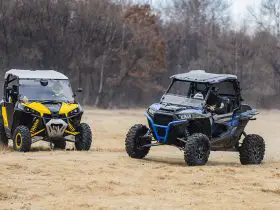Sometimes, fuel economy isn’t only about how much money you can save; it’s about driving through unscrupulous terrain without worrying about the next gas station’s location. That said, there aren’t many places to fuel up in the middle of nowhere, and carrying an extra tank of gas might prove a little cumbersome.
Luckily, off-road automobiles like UTVs, ATVs, and most dirt bikes aren’t subject to all rigorous government standards since they fall under recreational vehicles. As a result, most people customize the vehicle to enhance engine performance while complying with safety regulations and pollution limitations.
Others, however, know nothing about engine output and fuel efficiency. They will drive the hot rod exactly as it is from the dealer without any modifications. If you’re one of these people, then you probably know very little about UTV’s fuel economy, miles per gallon, and the factors that affect its engine performance. Let’s start with the basics:
Table of Contents
Maximizing the Fuel Economy on a UTV
A case study between different models and brands from known UTV manufacturers reveals that their average fuel economy is 20 miles per gallon. This in metric units can be branded as a UTV 11.761L per 100km. However, some models seem more overenthusiastic about their fuel consumption with respect to their engines also found on other UTVs. So, what exactly brings about this change?
Most manufacturers base their designs with respect to specific consumer needs. In general, you can narrow them down to the vehicle’s work capability, raw speed, and payload limit with an allowance to tune it up or down. Once you identify a model that tilts over towards one side, it’s also crucial to check out these factors that may affect the fuel economy on a UTV.
1. Aerodynamics
Like airplanes, automobiles also face the same drag found in fluid dynamics relative to the direction of propagation. In simple terms, the more compact the shape of a vehicle is, the less resistant it is to airflow. As a result, more energy is used, trying to cut through the air.
The same logic is used in the designing of supercars that are wedge-shaped and lower to the ground to cater for aerodynamics. If your UTV was built for speed, then the plastic design on its anterior should take up an aerodynamic profile. The Polaris Ranger 570 reaches maximum speeds of up to 50 mph or 80 kph.
2. Tire pressure
It’s no secret that driving on flat tires overworks the engines. Therefore, it goes without a saying that running on tires with uneven pressure might also affect your UTV mpg output. Most vehicles are designed with a set pressure recommended for optimum cruising performance.
3. Mass
Old car designs were phased out due to their more massive metallic build. Newer models are made with a lighter material that aids the engine to power through the vehicle’s body mass. Therefore, the lighter cargo you’re carrying, the lesser the strain on fuel consumption.
4. Braking Mechanism
Worn out bearings, clutch, and gearbox are detrimental in the fuel economy on any UTV. Similarly, dragging brake calipers will cap the speed of the car on freerolls, thereby reducing the displacement covered. Servicing is, therefore, beneficial to help curb this leak.
5. Horsepower
Different internal combustion engines are designed to max out on the throttle. Therefore, engines that can dish out a higher horsepower will likely consume more fuel than the ones that don’t. UTV’s aren’t exactly fuel guzzlers, but the sports models are more capable of dishing out more horsepower than regular models. For instance, the Kymco 450i’s top speed is 48 mph or about 77.25 kph while the Ranger 570 has 36 HP.
6. Terrain
You may be wondering what the road profile has anything to do with this, considering they are all off-road machines. Well, it doesn’t take a rocket scientist to figure out that steeper climbs consume more fuel than level roads. Moreover, muddy roads are more demanding of the payload the vehicle can offer. Smooth trails are the easiest to get across on these hot rods without much hindrance.
Comparisons between the fuel economy on a UTV, an ATV, a dirt bike and a regular pickup truck
The main differences between all these automobiles comes down to size, horsepower, and compartmentalization.
1. UTV vs. ATV fuel economies.
An all-terrain vehicle is made specifically for single-riders, whereas a Utility task vehicle allows for side by side riding. As a result, ATVs are much smaller, compact, and lighter. They are also more physically demanding to ride with no safety harnesses such as a seatbelt. Therefore, control is all about your timing maneuvering while straddling the seat.
On the other hand, UTVs allow for more passengers in their bucket style seats with the safety of the paramount with the inclusion of roll-cage-like enclosures. Since it is a utility vehicle, some models were designed with an extra compartment for packing your gear. Others were also intended to haul or tow other vehicles that may be stuck.
As a result, the UTV fuel economy is generally similar to ATVs. This mostly due to their size, weight, and powerful engine that dishes out more torque. Moreover, their acceleration time is typically longer as their top speeds drag about.
2. UTV vs. Enduro bikes fuel economy
The average mpg for motorcycles is 35-40 or 5.88L per 100km. On the other hand, some speed bikes can go up to 60 mpg or 3.92L per 100km depending on the engine and fuel type. In comparison, that’s a decent fuel economy compared to the UTV fuel economy, which is expected considering the bike’s size and weight.
However, most Enduro bikes don’t do well on mileage. The reason behind this is because most riders don’t buy the bikes for the economy but to offer thrills. Therefore, the factors mentioned above don’t really come into play. For example, air drag is enhanced by the rider whose body protrudes to resist airflow.
Similarly, the same rider also adds on to the weight on the bike, making it even harder to push forward. On a UTV, the driver’s weight is mostly negligible since the vehicle is already heavy enough as it is. However, adding on passengers increases the overall cargo weight causing it to power through using more fuel.
3. UTV vs. Pickup Truck fuel economy
Like the UTV, a pickup truck is in itself a utility vehicle. However, most buyers do not put into consideration the fuel-efficiency of a truck. Instead, they will focus on versatility and performance. Gone are the days whereby trucks with V8 engines were the most sought out for.
Technological advancements have brought forth turbochargers that can make smaller engines just as efficient and powerful as the V8 engines. On the plus side, you won’t have to worry about their guzzling abilities.
Moreover, most trucks power through with diesel engines. With that in mind, their utility also comes down to size. Small pickup trucks like the Chevrolet Colorado 2WD and GMC Canyon 2WD both have 2.8L, four cylinders, Automatic 6-speed diesel engines with a combined MPG of 23 or 10.2L per 100km. On the other hand, standard trucks like the Chevrolet Silverado 2WD 3.0L, six cylinders, Automatic 10-speed turbo diesel engine has a combined MPG of 27 or 8.712L per 100km.
While a pickup truck is more efficient than the average UTV, it definitely will cost you more. Be sure to pick out the best in terms of fuel-saving configurations with zero compromises on performance.
Climate Impact on Fuel Economy Standards
Climate change is all around us, with the transportation sector, contributing significantly to greenhouse gas emissions. These, in turn, send temperatures skyrocketing, causing all kinds of extreme weather anomalies.
Bringing politics into it, former president Barack Obama through the Obama GHG standards, would have cut carbon pollution by 50%. At the same time, it would also have doubled the fuel economy to about 54.5 mpg or 4.316L per 100km come the year 2025. However, President Trump contorted it to attack states working to reduce greenhouse gases, thereby increasing the climate impact on fuel economy.
So, can we do to reduce climate change and pollution?
• Buy a car with better gas mileage
• Opting for the best fuel economy out of your car
• Walking, biking, or taking public transportation means as often as possible
• Using low-carbon fuel alternatives such as ethanol or CNG
• Going green with electric vehicles or plug-in hybrids
• Uber recently came up with a devious plan called Uber-Pool that combines trips with different strangers. Not only is it an effective method of reducing carbon emissions, but it also saves on time and money.
Summary
When purchasing an automobile, whether it’s a UTV, ATV, truck, bike, or SUV, go for the most fuel-efficient models on top of performance. Not only will it help you save on gas money but also help in solving the climate crisis. Most UTVs already yield on the investment by helping out mostly on a ranch or farm setting. All it takes is the right choice of brand or model.









